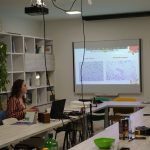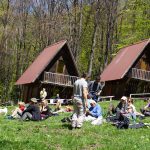During 2024, seven research projects are expected to be implemented as part of the Support Program for Young Ecologists “Dr. Ljupcho Melovski”. Below are the brief summaries of the research projects.
Empetrum nigrum – an unknown plant on Shar Mountain with great potential
Coordinator: Aleks Jachovski
In 2021, about 698 km2 of the area in Macedonia was declared a national park, following the development of a comprehensive valorization study. Empetrum (Latin: Empetrum nigrum, hereinafter EN) was found on the list of species found solely on Shar Mountain (SM). As one of the lesser-known representatives of the peaks of SM (as Empetro-Vaccinetum balcanicum Horvat 1935), it is a plant with a limited distribution area. EN is a low-growing plant with branches reaching up to 1m in length, green elliptical leaves, and black berries.
While the properties of EN are known in medicine, folk medicine, food, and tradition in various parts of the world, there are no literature data on its significance in the territory of SM (Lorion et al., 2021).
The aim of this project is to explore the distribution of EN, the state of the populations, the significance for the local population, and the chemical screening of some important bioactive chemical components.
Silbioeco Biodiversity in silage – microorganisms as a potential for ecosystem protection
Coordinator: Emira Zekiri
Nature harbors many sources of microorganisms with different potentials, some of which may have antibacterial and antifungal properties. This project aims to find natural strains of microorganisms with potential as biopesticides or animal probiotics. It will thoroughly investigate and provide data on naturally occurring microorganisms with antimicrobial activity to address various types of ecological problems. It is also known that plants have specific microorganisms in their rhizosphere with which they live in symbiosis and which serve to make silage. Silage is fermented food for livestock, often made from natural ingredients such as vegetables, grains, or other plant materials. The project will isolate new microorganisms that will support the health and performance of livestock or protect plants from phytopathogens, thus affecting the vitality of ecosystems.
Identification of possible presence of microplastics in Lake Ohrid
Coordinator: Ivo Ilincev
Lake Ohrid is the oldest and largest freshwater lake in Europe, housing 1200 species, more than 200 of which are endemic and relict, making it the richest lake in endemics per square meter globally. One of the main reasons for the possible loss of UNESCO protection is pollution from organic non-degradable waste, including plastic.
Microplastic (MP) contamination in water (marine and freshwater), sediment, air, salt, and biota has become a major global threat to the environment and an economic issue. In recent years, a significant number of scientific studies have been published on the harmful effects of microplastics.
FTIR and Raman techniques are vibrational spectroscopic methods (VSM) used to characterize various types of polymers, as well as in research on MP pollution.
The main project goal is to determine the presence of MP in Lake Ohrid by introducing vibrational spectroscopic techniques for rapid MP screening.
Biodiversity of Old-Growth Forests in Mavrovo National Park
Coordinator: Kristijan Jakimovski
The project aims to explore the species diversity of fungi in the old-growth forests within the area of Mavrovo National Park. Old-growth forests are forest communities that have not been exploited by humans, where old trees and fallen logs are preserved. Old trees provide suitable substrates and mycorrhizal partners for a large number of fungal species, with fallen logs being particularly significant, as they support various fungal species. The old-growth forests also include virgin beech forests found on Mount Korab – village of Žužnje, one of the planned sites for exploration. These forests are rare in our country and have not been sufficiently studied, with almost no data available on their mycodiversity. By researching these communities, we expect to contribute to understanding the diversity of fungi in this significant area, which is a national park. Therefore, old-growth forests represent an excellent challenge for research from a mycological perspective.
Microcosm in Water – Defining Natural Resources in the Skopje Valley and on Shar Mountain (SHAR-SKO-ECO)
Coordinator: Marija Karbeska
The modern and fast-paced way of life, hyper-industrialization, water pollution, air pollution, soil pollution, and overall environmental pollution pose a threat to the extinction of native biodiversity in nature. Mountains and water sources are constantly struggling to maintain their pristine purity, threatened by human factors. There is a significant difference in biodiversity from every aspect in polluted parts of ecosystems and in completely untouched areas. The goal of the project is to compare the water quality in differently located water sources and then examine the biodiversity of microorganisms present. In order to make a comparison of naturally occurring microbiomes and to illustrate the role of human factors in water pollution in a clean mountain environment and in sources from the Skopje Valley, as well as to analyze in an accredited laboratory, educational workshops with discussions on water protection and the level of pollution will be conducted.
YeastHarmony – Biodiversity of Wild Fruit and Grape Yeasts and Production of Unique Organic Wine
Coordinator: Natali Angeleska
Yeast is a part of the biomass of a large number of fruits, especially grapes. The wine-making process requires a fermentation process that occurs thanks to yeast. Wineries often use commercially available yeasts that give wine an identical taste and aroma. On the other hand, organic wine is a significant challenge and a current issue worldwide. The project’s goal is to isolate new yeasts from different types of wild and untreated fruits and grapevine plantations. The focus will be on the biodiversity of present yeasts from plants in the wild and untouched nature, and after isolation and characterization, a selection of isolates will be made. Then, wine will be made under laboratory conditions, which will be unique and organic, using organic farming to obtain organically produced grapes and naturally obtained yeast investigated in this study.
(ECO-K2 – KEFIR CULTURES) – Analysis of Biodiversity of Different Kefir Cultures and Their Use in Ecosystems
Coordinator: Stanimir Trpeski
Kefir, as a forgotten source of natural microorganisms, represents an important ethnological and cultural element of our region. Assessing the biodiversity of microbial communities in kefir and defining the microbial diversity in kefir grains and kefir products is of particular importance. The project aims to conduct research on how different environmental factors affect the composition of microbial communities in kefir. Historically, fermented food has been part of every culture worldwide and is a treasure trove of natural microorganisms beneficial to humans and nature. By everyday production of homemade fermented products, the carbon footprint in nature is reduced, and organic waste can be used in making this beverage. With this research, we aim to prove the biological diversity of microorganisms responsible for kefir fermentation through their isolation and characterization. These cultures potentially can be used in bioremediation, as bio-fertilizers, or in reducing organic waste through fermentation.



